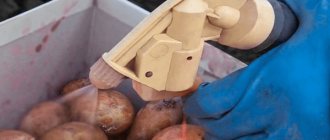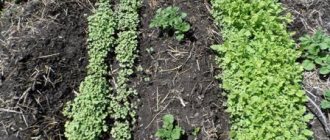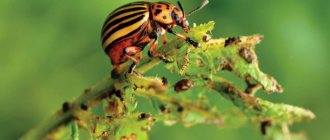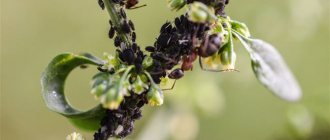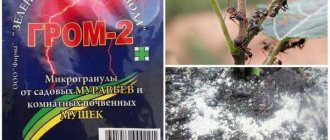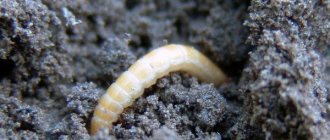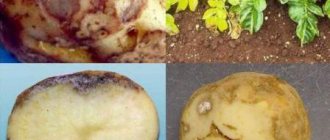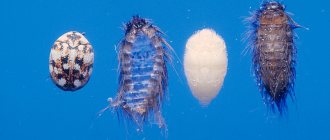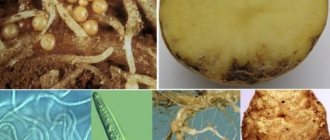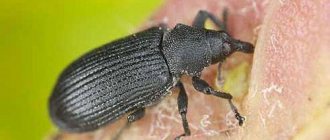Do underground pests in the garden gnaw on potatoes, carrots, beets, radishes, depriving you of hope for a harvest? We will tell you which insects are destroying your root crops and how to deal with pests on your site using a variety of methods.
The ones that most seriously damage underground plantings are mole crickets, wireworms (larvae of the click beetle), beetles (larvae of the May beetle), carrot flies and root-knot nematodes. Together, these creatures are capable of causing irreparable damage to the vegetable garden and flower garden. How to understand that they have settled in your dacha and, most importantly, how to get rid of such a dubious neighborhood?
Types of insects in the soil
Various pests live on the soil surface or at shallow depths:
- herbivorous mites;
- nematodes;
- soil insects (mole crickets, leaf beetles, etc.).
Some types of insect pests lay eggs in the ground, and their larvae (caterpillars), emerging from eggs, destroy the root system, tubers, and root crops.
This group includes:
- darkling beetles;
- weevils;
- May beetles (Khrushchi);
- Lepidoptera (moths and butterflies);
- nutcrackers.
Plant protection from pests and diseases
High-quality pre-sowing work allows you to avoid many problems and difficulties in the summer. The following measures help prevent attacks by insects and animals, as well as diseases spread by parasites:
- Biological. These include the use against pests and pathogens of their natural enemies, i.e. predatory insects, birds, and also use bacteria, fungi and viruses that cause the death of pests.
- Agrotechnical. This category includes special soil treatment, compliance with planting and harvesting dates, proper use of fertilizers, and timely weeding of beds with plants.
- Chemical. They combine seed treatment with fungicides and the use of rodenticides to prevent the invasion of moles and mice.
Cultivated plants are very vulnerable to pest attacks. Competent, timely measures help protect plantings from dangerous insects and animals. All gardeners and gardeners are recommended to study in detail methods of resisting parasites, allowing them to keep their plants healthy and get a generous harvest.
Why is mole cricket dangerous and how to get rid of it?
The mole cricket is a large (5-6 cm) pest of garden plants, whose scientific name means “mole cricket”. The insect's forelimbs are modified like a mole's paws; with them, the mole cricket digs a system of tunnels and passages in the ground. It is very difficult to see insects, since they are nocturnal exclusively underground. The presence of a mole cricket in the garden is indicated by mounds of dug up earth with a round hole in the middle.
Medvedka
Adults and larvae eat succulent, nutritious underground parts of plants:
- root system;
- tubers;
- roots.
Mole cricket larvae are similar to adult insects, only smaller in size, and their diet is the same. Several hundred larvae can emerge from one clutch. In temperate and northern climates, they develop for several years (3-5), causing significant damage to garden plants.
One of the effective ways to combat mole crickets is to loosen the soil in May-June, when reproduction occurs. During digging, fresh masonry is discovered and destroyed.
Before planting, insecticide bait is added to the holes. Effective against mole crickets:
- "Thunder";
- "Grizzly";
- "Phenaxin plus";
- "Beargon."
Traditional methods are also used:
- laying eggs are poured with boiling water;
- spill the soil with a soap solution (200 g of soap per bucket of water);
- watering with infusion of onion peels;
- they set up traps - a bottle with a narrow neck and a wide bottom, for example, champagne, dug in at an angle, filled with fermenting liquid. Insects crawl in and die because they cannot get out.
Other types of pests
Some polyphagous and soil parasites are found in gardens and orchards. The first type of pest is distinguished by its ability to eat everything indiscriminately, without switching between plant species.
Soil parasites live underground. These harmful creatures prefer root vegetables.
Polyphagous
Such pests include:
- Meadow moth.
- Field mice.
meadow moth
The meadow moth ("blizzard") is a small butterfly with grayish-brown wings with two yellowish spots. Harm to cultivated plants is caused by the caterpillars of this insect. They gnaw holes in the leaves, “skeletonizing” them, eat the leaf blade down to the petiole, and can eat the stems. Plants such as sugar beets, corn, and sunflowers suffer the most from pests. Caterpillars love vegetables and potato seedlings.
Entomophages and Trichogramma help reduce the number of insects. Among biological preparations, Bitoxibacillin and Lepidocid are used. When the parasite spreads significantly (more than 5 pests per square meter), insecticides are used.
Field mice
These small rodents with a red-brown back and white belly live in fields, vegetable gardens, and orchards. Such pests are very prolific, create numerous nests and can quickly infest agricultural land.
Field mice chew on everything they come across on their way. This is due to the need for constant growth of teeth and the need to grind them down. In addition to harming beneficial plants, rodents carry dangerous diseases (hemorrhagic fever, tularemia, leptospirosis, erysipelas). The pests themselves may not get sick.
Suitable for mouse control:
- physical methods (mousetraps, traps, repellers);
- chemicals (poisons, aerosols);
- traditional methods (essential oils, building mixtures).
To avoid the appearance of the pest on the site, it is recommended to periodically loosen the soil, keep the area clean, and prevent the accumulation of garbage. An infusion of red elderberry (100 g per 1 liter) is good at repelling animals.
Soil
The soil type of pests is represented by parasites such as khrushchev, shrew, and mole rat.
Khrushchev
This pest is the larva of the cockchafer. Its food includes the roots of trees and shrubs, root vegetables (carrots, beets, radishes). The larva completely or partially eats the underground part of the plant, making it weak and defenseless against viral and fungal infections.
Entomophages (magpies, starlings, rooks, hedgehogs) help get rid of the parasite. Of the synthetic products, the drug Vallara, intended for application to the soil, is effective.
Shrew
A small animal with a long trunk digs numerous underground passages in the area and harms useful plants. When the shrew is active, the root system of the plantings is seriously damaged and the yield is reduced significantly.
Folk methods of expelling the pest from an area where there are useful plants are filling its holes with water, using strong-smelling substances (naphthalene, kerosene, gasoline). Of the chemicals intended to combat rodents, Rat Death, Nutcracker, and Hunter Anti-Rodent work well.
Common mole rat
This underground animal can be quite large (up to 35 cm in length). The mole rat loves to eat root vegetables (carrots, potatoes, beets). The parasite is especially attracted to well-kept, neat beds. Mole rats live in burrows located at a depth of up to 3 m.
It is quite problematic to drive away a pest that has chosen a certain area. Measures to combat the annoying animal - traps, traps, poisons, ultrasonic repellers.
In many cases, an ordinary cat helps to cope with mole rats. To protect the plants, they also resort to flooding the burrows with large volumes of water.
The water method of pest control is ineffective if the soil is sandy or very loose.
The danger of wireworms (larvae of the click beetle), control and prevention measures
Adult black click beetles are common phytophagous pests. Their larvae are long (1.5-3.5 cm) and thin (0.2 cm), having a yellowish color and a metallic sheen - they are called wireworms. The larvae live in the ground and prefer:
- root system of cereals;
- tubers and root vegetables: potatoes, beets, root parsley, parsnips;
- flower bulbs;
- corn;
- sunflower.
Wireworm
Capable of completely destroying sown seeds, the root system of young seedlings, and seedlings. Beetle larvae live in the garden for up to 3-4 years.
Fighting methods:
- before planting, the insecticide Bazudin (analogues of Pochin, Zemlin, Kapkan) mixed with sand or sawdust is added to the holes;
- potato bait: stick a stick into a small piece and lower it into the ground. Periodically, the trap is taken out, the wireworms are destroyed, and the bait is replaced with fresh bait.
As preventive measures:
- compliance with crop rotation;
- planting green manure legumes to saturate the soil with nitrogen;
- weeding, especially carefully it is necessary to destroy wheatgrass - a grass on the roots of which there are often accumulations of wireworms;
- cleaning the area at the end of the season from tops, leaves, etc.
Snow Beetle
One of the common pests is the large black beetle in the garden or strigun (kravchik). It is colored black, has a body size of several centimeters, lives in underground burrows and has a hard shell, which is why even birds cannot eat it.
Black earthen beetles usually appear in early spring, cutting off the first shoots of weeds. After the seedlings appear in the garden, pests are taken for them. Striguns are able to quickly destroy all planted seedlings of garden crops, not even disdaining garlic and onions.
To combat the earthen beetle, gardeners use various traditional methods, ranging from manual collection to digging trenches and installing metal profile sheets around the perimeter of the garden.
Usually, at the beginning of June, these long black beetles already finish their destructive activities, burrowing deep underground and laying eggs to provide themselves with offspring. Therefore, only deep digging of the earth in the fall can help destroy pests, during which the larvae that fall to the surface freeze and die.
How to deal with the larvae of the May beetle (Khrushchev) and preventive measures
Adult chafers are not harmful garden pests. Their larvae are especially dangerous - large, thick, white, which live in the soil at a depth of 10-25 cm for 3-4 years. One pest larva is capable of completely gnawing the root system of a two-year-old seedling in 2 days.
May beetle larvae
The female lays eggs in loose soil, and the larvae grow there. To prevent this:
- dig up the area at the end of the season to find beetle larvae preparing for winter;
- mulch the soil in spring and summer (bark, sawdust, chopped straw);
- plant plants that enrich the soil with nitrogen, white clover is best;
- attract natural enemies of larvae to the site - insectivorous birds (jays, orioles, magpies, starlings, blackbirds);
- Before planting in the ground, treat the root system with a solution of a Vallar-type preparation to protect it from being eaten by larvae.
Chemicals against pests*
| Pest | List of drugs | Mode of application |
| Wireworm | Pochin, Zemlin, Vallar, Terradox, Provotox, Biotlin, Bison, Imidor, Iskra, Kalash, Klubneshield, Commander, Corado, Prestige, Prestigator, Respect, Tanrek | Application to the soil before planting |
| Khrushchev | Vallar, Terradox | Dipping the roots of seedlings (seedlings) into insecticidal soil mash before planting and re-applying the drug after 25–30 days to the surface of the earth with embedding to a depth of 5–10 cm. |
Select from the list
Why is carrot fly dangerous, methods of control and preventive measures
The carrot fly is a small (0.5 cm) insect whose larvae live in the soil in the garden. During the season, the fly lays several hundred eggs in 2-3 batches, preferring moist, shaded areas. Larvae, similar to worms (up to 1 cm in length), bore tunnels in root crops, making them bitter and unsuitable for storage.
It is difficult to combat garden pests; for this, potent insecticides are used:
- Arrivo;
- Boreas;
- Vantex.
carrot fly
For planting, it is worth choosing varieties that are resistant to this pest. Also as preventative measures:
- For carrots, you should choose dry, sunlit areas;
- plant onions, garlic, and marigolds between rows to repel pests;
- Remove weeded and thinned carrot seedlings from the area so as not to attract flies with the smell.
carrot fly
Main harm
The favorite “dishes” of the carrot fly are celery, root parsley, and dill. Damaged plants cannot be stored and deteriorate.
Carrot fly (Photo from wikimedia)
How to prevent the appearance?
- Plant seeds that are resistant to this pest.
- Make beds in sunny areas.
- Do not leave picked plants between the beds.
- Plant marigolds nearby.
- Do not fertilize with fresh manure.
Fighting methods
- Sprinkle tobacco and onion peels between rows.
- Spray the plants with a soap solution or a decoction of tomato tops.
- Use medications (“Vantex”, “Borey”, “Karate Zeon”, “Tsipi”, “Arrivo”).
The danger of root-knot nematode: how to fight and preventive measures
Microscopic roundworms living in the soil in the garden cause a disease called meloidogynosis. At the same time, galls are formed on the roots - swellings that prevent normal plant nutrition. Through damage, infection occurs with fungal, viral, and parasitic diseases. Productivity is reduced several times.
Biological products have proven themselves to be excellent in the fight against nematodes in the garden:
- Fitoverm;
- Metarizin;
- Aversectin S;
- Nematophagin BT.
Prevention:
- Before planting, the soil and root system of seedlings are disinfected with hot water.
- Weeding and thinning are carried out.
- Removal and burning of affected plants is necessary.
- It is recommended to plant natural phytoncides between rows.
- It would not be superfluous to plant green manure plants in the soil.
Soil insects
Soil insects
usually live in the soil during the period when they damage plants.
As a rule, they damage roots and other underground parts of plants. But some insects can feed on or damage the above-ground parts of the plant. Some of the most dangerous soil pests include cutworms, Colaspis beetles, root aphids, corn rootworms, corn rootworms and wireworms.
Various types of cutworms
. Gnawing cutworms ring young plants, often causing thinning of the stems. Caterpillars, which have a thick body, can often be found curled up in a ring near the plants they damage. The color of the caterpillars varies from dull light gray to grayish-black or brown. They usually feed at night and gnaw at plants at or below the soil surface. Butterflies are colored gray or brown. Eggs are usually laid in early autumn, and the caterpillars, as a rule, develop on forage crops, where they overwinter.
There has been almost no work on developing corn lines resistant to armyworms. Differences in corn resistance can be assessed by determining the percentage of plants damaged or killed. To combat cutworms, you can use scattering baits poisoned with carbaryl (Sevin) during the period when the caterpillars begin to gnaw on plants. The pesticide consumption rate is 1.1 kg of active ingredient per 1 ha. If necessary, scattering of baits should be repeated. To destroy young caterpillars, it is advisable to include plowing into the plot's treatment plan at the end of summer or early autumn.
Beetle
Colaspis flavida
. Beetle larvae feeding on the roots of young plants often thin out crops and cause severe variation in plant height and reddening. Symptoms of corn damage by the C. flavida beetle are similar to those of phosphorus starvation. Severe damage is often observed on plants growing in relatively poor soils from red clover, lespedeza, middle clover, soybeans or timothy.
Differences in the resistance of corn lines can be rated on a scale from 1 (slight damage) to 5 (most severe damage). Good results in the fight against C. flavida are obtained by introducing insecticides into the soil during sowing. In order to combat this pest, it is advisable to avoid planting corn on clover plowed in the spring or plowed timothy sod.
Root
aphid
(Anuraphis maidi radicis). Root aphids live in clusters on the roots of corn plants. They suck the juices out of them, as a result of which the plants stop growing and become stunted. The presence of root aphids is evidenced by numerous anthills on corn crops.
The resistance of breeding material can be assessed on a scale from 1, indicating the least severe short stature or dwarfism, to 5, indicating the most severe damage. To combat root aphids, crop rotations are recommended.
Corn beetle
(Diabrotica sp.). The corn beetle often thins out crops, retards the development and growth of plants, and even causes dwarfism. The larvae feed on the root collar of young plants and can kill the apical bud or cause intensive formation of axillary shoots. In older plants, they often damage the roots, which leads to lodging of corn and reduced yields. Adult beetles damage the filaments and can interfere with pollination and fertilization.
White or pale yellow, thin larvae of the northern corn rootworm (Diabrotica longicornis) reach a length of about 10 mm. The length of adult beetles is 5 mm; they are colored pale green.
The larvae of the southern corn rootworm (D. undecimpunctata howardi) are thin, white or yellowish, about 13 mm long. Adult beetles reach a length of about 7 mm, are colored green, with a black spot on the elytra.
Bigger, Holbert, Flint and Lang, Bigger, Snelling and Blanchard reported differences in the degree of tolerance to southern corn rootworm among inbred lines and corn hybrids. These researchers showed that tolerance is related to the ability of plants to regenerate new root systems, resist root rot, and not die under conditions of heavy corn rootworm infestation. Differences in tolerance can be expressed as the percentage of plants with root lodging.
Crop rotation, sowing of resistant lines and the use of insecticides are recommended as control measures. During sowing, it is recommended to apply insecticides such as bucks, carbofuran, dasanite, daifonate, landrin or mocap to the soil at a consumption rate of 1.1 kg of active ingredient per 1 ha.
Khrushchev larvae
(Phyllophaga sp.). Beetleworm larvae often severely damage corn sown on annual or perennial grass. Feeding on the roots of young plants, they often thin out stems and retard plant growth. In damaged adult plants, root lodging is possible.
Bigger, Flint, Shropshire and Farrar reported that beetle larvae feeding on the roots of simple hybrids caused lodging of 80% of TrXL317 plants compared to 6% of lodging of 90X4211 plants.
Hogemeyer described wide variations in the degree of lodging caused by beetle larvae feeding on the roots of six inbred lines, 15 possible single hybrids, and 29 of 45 possible double hybrid combinations between them. Inbred lines differed little in their resistance to damage by beetle larvae. However, simple and double hybrids differed greatly in both root damage and lodging. The most resistant simple hybrid (K41ХК54) had 20% of its plants killed, compared to 87% of the laid down plants of the K41ХК63 hybrid.
The susceptibility of inbred lines or hybrids to damage by beetle larvae can be assessed by dividing them into five classes. Root lodging can be expressed as the percentage of plants that have deviated 30° or more from vertical. Adding insecticides to the soil at the time of planting usually helps control this pest.
Wireworms
(Agriotes mancus) and other species. Wireworms (larvae of click beetles) damage germinating seeds and young shoots, thus severely damaging the crop and thinning out the crops. The most severe damage is observed in damp areas of fields that have come out from under the grass layer or grain crops. Wireworms also feed on the roots of older corn, causing premature death of the plants. The larvae look like thin, shiny, light yellow to reddish-brown worms with a length of 12.5 to 37 mm.
Almost no attempts have been made to develop forms of corn that are resistant to these pests. An idea of differences in resistance can be obtained by recording the percentage of damaged plants. In the fight against wireworm infestation of crops, crop rotations with short rotation, careful cultivation, fallowing and draining the soil are recommended. Some new insecticides also provide effective results in the practical control of these pests.
Nematodes
. Nematodes are not insects, but at least 12 different species of these worms damage corn. Typical damage caused to corn is caused by root nematodes. They reach 0.8 mm in length and 0.0025 mm in width; therefore, they are almost invisible to the naked eye, but in a microscope they are easily distinguishable in the form of tiny worms. Root nematodes live in the bark of corn roots and feed on root cells. As they slowly move along the roots, they leave behind a number of dead cells and, from time to time, an egg. From these eggs larvae hatch and reach maturity in the same root, if it is not too badly decomposed. The larvae leave the rotten root and wander through the soil in search of another.
To combat nematodes, crop rotation or chemical methods are used; their harmfulness can be minimized by sowing resistant varieties of corn. Plants that are truly resistant suppress the proliferation of nematodes. The reproduction of nematodes on resistant varieties of corn is only 1% of their reproduction on susceptible varieties.
When testing corn plants for nematode resistance, it is necessary to monitor whether nematodes are able to reproduce on these plants or not.
If you find an error, please select a piece of text and press Ctrl+Enter.
Harm and methods of combating flea beetles, including preventive measures
Small (up to 4 mm) shiny leaf beetles with strong legs capable of high jumps prefer plants from the cruciferous family:
- cabbage;
- radish;
- turnip;
- daikon;
- radish.
And also flowers:
- gillyflowers;
- Iberis;
- lacfiol;
- fuchsia
Earth flea
The female lays eggs in the top layer of soil 3 times during the summer. The larvae live underground, feeding on roots. Adult beetles eat the upper parts of the leaves.
A proven folk method of control is dusting with wood ash, which can be mixed with tobacco powder (crumbs) in a 1:1 ratio. The procedure is repeated once a week.
Chemicals:
- Aktelik;
- Decis;
- Bankol.
For prevention:
- seedlings should be covered with non-woven material;
- plant repellent plants (dill, marigolds, garlic);
- prevent the appearance of cruciferous weeds (shepherd's purse, rapeseed) on the site, where pests multiply;
- Carry out abundant watering, preferably by sprinkling, to repel fleas that prefer to settle in damp soil;
- practice loosening the soil.
Underground animals - who lives underground? TOP 10 with photos and descriptions
Many birds, mammals, reptiles, insects, etc. live on the surface of the earth. However, there are also animals that live underground. This article will tell you about creatures that live underground almost their entire lives. Underground animals - who lives underground photo TOP 10 - look!
Underground animals - who lives underground photo TOP 10
Underground animals - who lives underground photo - naked mole rat
This small rodent belongs to the mole rat family. Its distinctive features are cold-bloodedness, lack of sensitivity to pain and various acids. Of all the rodents, the naked mole rat lives the longest - 28 years. Perhaps this baby may outwardly scare someone, but in reality this animal is not aggressive and kind.
Underground animals - who lives underground photo - giant mole rat
Of all the representatives of mole rats, the giant mole rat is the largest. This giant reaches 35 centimeters in length and weighs about one kilogram. The upper body is colored light gray or ocher-brown. This underground creature lives only underground, never emerging from its structures. Mole rats love to build multi-tiered systems of entrances and exits. Most often, they dig their feeding passages at a depth of 30-50 centimeters, usually in layers of sand. The entire length of these feeds reaches 500 meters, but there are passages even shorter. Storerooms and nesting chambers of mole rats are located at a depth of up to 3 meters. These creatures have huge teeth that can easily bite through the bayonet of a shovel, so it is better not to pick them up.
Underground animals - who lives underground photo - mole
Even small children know that the mole is an underground animal. Moles belong to mammals, to the order of insectivores. Moles live in Eurasia and North America. Moles come in both very small and large sizes. For example, some of them barely reach 5 centimeters, while others grow up to 20 centimeters. The weight of moles ranges from 9 grams to 170 grams. Moles are perfectly adapted to life underground. The body of these creatures is elongated, round, on which there is smooth and velvety fur. The main feature of the mole, which helps it move in any direction underground, is its fur coat, the fibers of which grow upward.
Underground animals - who lives underground photo - tuco-tuco
Tiny rodents whose weight does not exceed 700 grams. The babies reach 20-25 centimeters in length, and the length of their tail can reach 8 centimeters. The morphological characteristics of these animals fully indicate that they are adapted to life underground. Tuco-tuco leads an exclusively underground lifestyle, they build many intricate passages in which their storerooms, latrines and nesting chambers are stored. Animals use sandy or loose soils to build their homes.
Underground animals - who lives underground photo - gopher
The next creature reaches 10-35 centimeters in length, and its tail is 5-15 centimeters. The weight of gophers barely reaches one kilogram. The animals spend most of their lives in their intricate passages, which they make on various soil horizons. The length of the tunnels can reach 100 meters.
Underground animals - who lives underground photo - spotted snake
This species belongs to the cylindrical genus. The snake is quite small in size, but very dense. The color of the snake is black with brown spots arranged in two rows. It lives only underground and feeds on earthworms.
Underground animals - who lives underground photo - simple crucian carp
This fish almost always lives in the bottom mule, but when the reservoir dries up, it burrows underground. Crucian carp can dig from 1 to 10 meters, and can live underground for several years.
Underground animals - who lives underground photo - mole cricket
This insect is one of the largest. The mole cricket can grow up to 5 centimeters in length. The belly of this creature is three times larger than the cephalothorax, soft to the touch, and reaches 1 centimeter in diameter. At the end of the abdomen there are thread-like paired appendages, the length of which is 1 centimeter. Like other creatures on this list, the mole cricket leads an underground lifestyle, but there are times when the insect comes to the surface, usually at night.
Underground animals - who lives underground photo - cockchafer
Adults of the eastern type reach a length of 28 millimeters, and of the western type - 32 millimeters. Their body is black and their wings are dark brown. May beetles live underground, but in May they come to the surface and live there for about two months. After two weeks, the mating process occurs, as a result of which the female lays eggs underground at a depth of 20 centimeters. The process of laying eggs can be carried out in several stages at once, as a result of which the female lays about 70 eggs. As soon as the clutch comes to an end, the female immediately dies.
Underground animals - who lives underground photo - earthworm
The worms grow up to 2 meters in length, and their body consists of a huge number of ring-shaped segments. When moving, the worms rely on special bristles, which are located on each ring, with the exception of the front one. The approximate number of bristles on each segment ranges from 8 to several dozen. Earthworms can be found everywhere except Antarctica, as they do not live there. Despite the fact that they lead an underground lifestyle, worms crawl to the surface of the earth after rain, which is why they got their name.
How to deal with fall armyworm and the damage it causes
Large gray butterflies, garden pests, fly at night. During the season, the female is capable of laying up to 2 thousand eggs on the lower part of the leaves. Large, glossy caterpillars live in the top layer of soil and have a coloring that allows them to remain undetected. For plants, damage by the cutworm caterpillar is detrimental - it can cut the stem at ground level and eats leaves and seeds, especially sprouted ones.
Effective control measures:
- deep digging of the soil at the end of the season will destroy caterpillars preparing for winter;
- Traps are suitable for catching adult insects: hang cans of fermenting drink (kvass, beer, honey solution) on trees. The butterflies fall into the jar and die.
Fall armyworm
Insecticides against caterpillars:
- Arrivo;
- Sherpa;
- Decis;
- Bazudin.
Fat - different
In the soil you can find fleshy, light-colored insect larvae rolled into half rings. They can be either harmful or relatively harmless, and the pest can be identified... by its legs!
Dangerous
Adult beetleworm larvae are quite large (depending on the species, from 1.5 to 7.5 cm in length), fat, curved like the letter “C”, yellowish-white with translucent intestines. Try to remember a good identifying feature of beetle larvae: the back pair of their legs is the longest.
Prevention. Weed control. Some of the beetle larvae die when the soil is compacted in the spring.
Fight without harm. Collection and destruction of larvae during soil cultivation. Daily shaking off cockchafers onto shields or gauze cloths and their subsequent destruction.
They do harm, but rarely
Bronzewort larvae are often mistaken for Khrushchev larvae, which is not surprising, since they are the closest relatives. True, the larvae of bronzes have all pairs of legs of the same length. Bronze beetles can cause harm in rare cases - sometimes these beautiful bronze beetles eat plant flowers, and their larvae cause bald spots on the lawn.
Harmless
When digging up an area, you can find greenish-brown or dirty white larvae with a clearly visible head and a body curved in the shape of the letter “C”, very similar to Khrushchev larvae, but with long front legs (Khrushchi have the longest hind legs ). These are the larvae of pill beetles and dung beetles. They do not harm plants!
A large number of different creatures live below the surface of the soil. All of them are ideally adapted to specific living conditions.
Other ground insect pests
Many pests can live on a personal plot:
- in onions - thrips and underground mites;
- in potato tubers - golden nematode, potato flea beetle;
- cucumber roots are parasitized by cucumber mosquito larvae;
- cabbage fly larvae living in the ground infect the roots of the plant and cause death;
- onion moth lays eggs in the soil next to the plant, the caterpillars penetrate the onion stem and feed on it;
- polyphagous snails damage above-ground and underground parts of peppers, cauliflower and white cabbage.
Root nematode
Main harm
They settle on the roots of plants and form growths (galls) on them. These new growths interfere with normal metabolism in the plant, and it dies. Potatoes are most often affected.
Galls on leaves (Photo from biathlonmordovia.ru)
How to prevent the appearance?
- Maintain crop rotation.
- Plant nematode-resistant varieties.
- Treat the seed with water 50–55°.
- Water the area with water 50–55°. Cover with cling film to cool.
- Don't plant too thickly.
- Plant marigolds between the beds.
- Completely clear the area of plucked plants and do not leave last year’s crop residues.
Chafer
May beetles are quite small representatives of the underground world:
- length – 25 – 32 millimeters (adults may belong to the Eastern or Western Vedas);
- black dense body;
- small red wings.
Adult individuals can appear on the surface of the earth in the second half of spring, and after this event the life span does not exceed 1.5 months. Females die after they have laid several dozen eggs.
